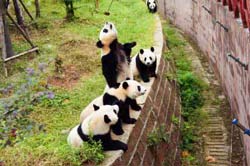Zoos, scientific research centers, breeding centers, or semi-protected areas work together to maintain a self-sustaining population of a given species. This population may serve as a hedge against extinction of the species, as well as a reservoir for improved understanding of its natural history. The Chengdu Panda Base is an example of a scientific institute engaged in research towards conservation. Our goal is not only to provide technical support for scientific research on wild pandas, but also to increase the wild population through improved management and, ultimately reintroduction of individuals into areas from which the populations have declined. Research at the Chengdu Panda Base focuses on the advancement of wildlife conservation in China. The giant panda is the principle species of interest; others include the South China tiger, the red panda, the golden monkey and others. Research areas include reproduction, nutrition, veterinary medicine, behavior and more. Advances in these fields enable us to provide optimal care for the captive populations. Furthermore, findings from and research are reciprocally applied to the improved management of both wild and captive populations. As of 2005, the Chengdu Panda Base received 59 awards for scientific achievements from the Chinese State Government, Sichuan Provincial Government, and Chengdu Municipal Government. More than 200 articles have been published in Chinese and international journals. We are the first to achieve breakthroughs in captive breeding such as artificial insemination and helping twins to survive. We have made advances in frozen semen technology to help overcome mating difficulties in captive giant pandas. This technology allows us to perform artificial insemination of females. Additionally, it allows the exchange of semen from males among breeding centers to improve the genetic diversity of the captive population. Perfection of cryopreservation of semen could allow this technology to be used in the field. We have also set up the largest semen bank and the only cell bank for giant pandas in the world. We assisted in setting up a giant panda studbook to optimize management of the captive population. Our research capacity continues to grow and strengthen every year. Our Research Center has three floors dedicated to modern laboratories, as well as one floor dedicated to educating the public on the research we conduct to promote the survival of Chinese endangered species. We have highly trained research staff and collaborate with researchers from 8 different countries, as well as scientists from all over China. Our Research Center and international network of scientists provides a platform for systematic research.
|
|

Cheng du Panda Base

 |

